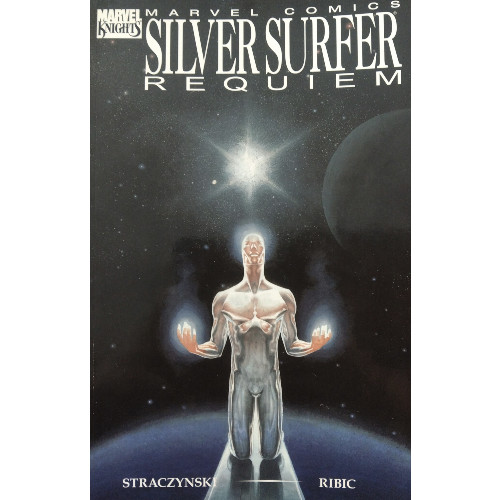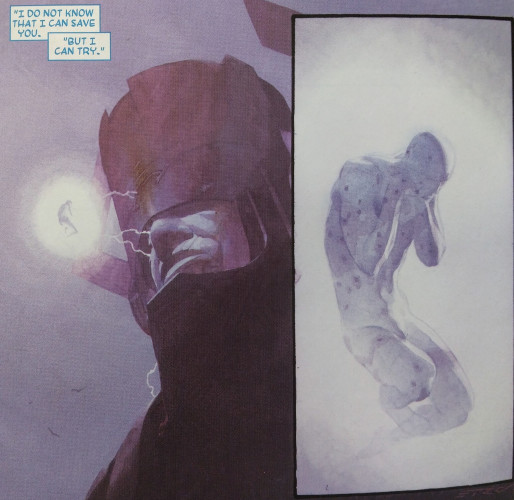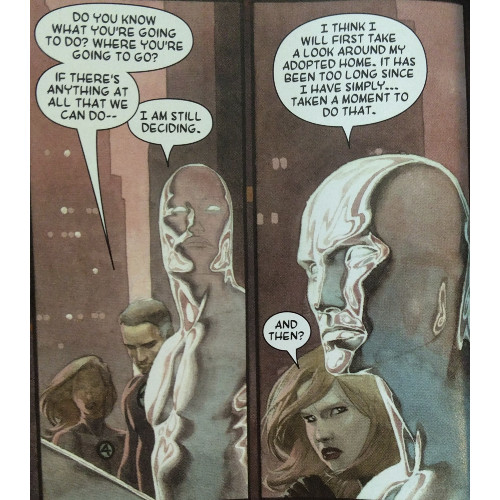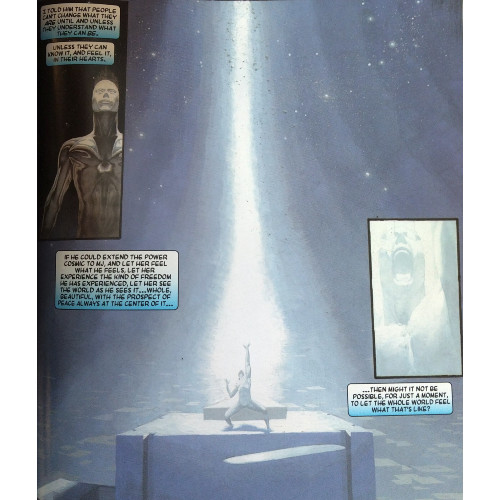(Strand)om Stories: Silver Surfer: Requiem Review
This series' only sin is being too short, it's artistic beauty and narrative depth creating a longing for more
—by Nathan on June 19, 2025—

In Marvel's oeuvre, there are at least two cosmically-powered superheroes who share two commonalities: (1. their stories were written at one point by Jim Starlin, and (2. they each received fairly definitive endings to their grand operas of existence.
One is Captain Marvel, the subject of Marvel's first oversized graphic novel, penned and illustrated by Starlin himself.
The other is the Silver Surfer, who may be (at least, according to the Cambridge History of the Graphic Novel, which is, yes, a volume I own, thank you) the subject of Marvel's first "official" graphic novel (which I also own, thank you), in that it was published as a standalone narrative and packaged as a trade volume rather than a standard comic book. That was devised by Stan Lee and Jack Kirby, and I will need to review it at some point here, for sure. While Starlin initially wrote Captain Marvel during the 70s, he penned the Surfer's adventures during the 90s, primarily using the character to build up to The Infinity Gauntlet.
But Starlin did not write of the Surfer's final days.
That honor went to J. Michael Straczynski, who has not made much of an appearance at all on this site, outside a few references. I'm fairly distant from his Amazing Spider-Man run in "Spider-view," and though I've read his work on Thor, I have yet to review it.
I actually picked this volume up for one primary reason: a podcast I listen to reviewed it, and having known of the narrative for a while, I was curious to finally give it a shot so I could listen to the episode spoiler-free. Happily, upon reading this four-issue limited series from the Marvel Knights banner, I discovered other reasons to appreciate the Surfer's final jaunt into the cosmos. As I recently reviewed an early issue of his original ongoing series, I wanted to take a moment and reflect on this limited series, an ending to balance out my recent explorations so near his beginnings.
Silver Surfer: Requiem
Writer: J. Michael Straczynski
Penciler: Esad Ribic
Inker: Esad Ribic
Colorist: Esad Ribic
Letterer: Corey Petit
Issues Collected: Silver Surfer: Requiem #1-4
Volume Publication Date: January 2008
Issue Publication Dates: July 2007-October 2007

In Catholic tradition, a Requiem is a mass held for the deceased, usually in the form of a funeral service. The word brings to my mind the phrase "requiescat in pace," the Latin form of "rest in peace," and I hope I don't upset anyone by mentioning the main reason I recall that phrase is thanks to Assassin's Creed 2. I am not Catholic, but I can understand the word and its meaning. A service for those who have approached their final rest.
Which, in a way, is what we're offered here: an extended funeral service for a dear friend.
This is the Silver Surfer's final flight, imagined by Straczynski and Esad Ribic in an alternate universe (though a current limited series seems intent on ending the mainstream Surfer's surfing), played out across four issues which challenge you to reach the end without feeling even a hint of emotion. Go ahead. Try. You'll fail.

The easiest narrative to compare this series to, as I detailed in the introduction, is Starlin's The Death of Captain Marvel, for the reasons I enumerated–dying superhero, cosmic backdrop–plus several others. Like Mar-Vell, the Surfer is afflicted with a disease he seeks succor from by approaching the world's most brilliant men. Like in the graphic novel, this series' eggheads do what they can to find a cure for their friend. And like Mar-vell's own journey into life's end, so the Surfer approaches the doors of death.
Straczynski, though playing with a premise similar to Starlin's graphic novel, veers sharply away from familiar star systems once the silver foundation has been poured. His focus is less on superheroes and scientists seeking a cure than it is on the Surfer's surprisingly serene acceptance of his truncated timetable. Starlin had the captain recall his past adventures and spent his final moments surrounded by enemies and allies alike. There is less reflection on the past in Requiem–though there is some–and more lingering on the present, on how the Surfer can spend these final days, hours, moments.

The Surfer has always been a philosophical character, and under the pen of Stan Lee, he waxed poetic on the foibles and frustrations of humanity as he roamed the Earth, a prisoner chained to our little blue ball in the galaxy. Straczynski equips a similar level of thoughtfulness here, but his Surfer is more active. Like in Lee's stories, Straczynski calls out the horrors of the world, sewing in enough generalities that readers can glean the overall meaning and then apply their own specific experiences without feeling the writer is taking anyone to task. Straczynski's Norrin Radd, however, doesn't just lament the state of the world. The Surfer takes steps to provide a change, however impermanent, to at least offer the concept of hope to humanity, to make them feel, collectively, strong enough to shape the world into something better. You, the reader, are to be left wondering what you could do with a bit of that cosmic hope…and then determining if maybe there actually is something there for you to grasp.
Straczynski also turns to parables, one of Lee's favorite storytelling devices in his Surfer narratives (and not least of which is because Lee once wrote a two-issue Surfer limited series titled "Parable"). When the Silver Surfer encounters alien races actively at war with one another, he must decide whether to engage with their thorny politics and beliefs or cut right through the whole mess. Here, again, the reader is encouraged to identify real world examples of this conflict, to understand the Surfer's solution and wonder if anything applicable can be found.

The middle two issues are really intended to be a celebration of the character and how he has, historically, contemplatively addressed both earthbound and interstellar conflicts. It's the Surfer doing what he does best, becoming involved with the temperamental, often facetious problems of others and steering them towards some form of resolution, usually the correct solution but not always one to the liking of those in conflict. He is not above or untouched by warfare, pain, or suffering, but he does not allow it to prevent him from forging ahead, even as he's dying.
Part of me wishes we could have been given a little more in this series. What Straczynski and Ribic present is wonderful and very touching. Each issue has its own identity, with the final chapter presenting the best possible Requiem for a hero of the Surfer's standing, meaning each issue has its own purpose. The series needs no trimming. There are no needless subplots, no extraneous characters, no wasted moments. It doesn't end abruptly either. Perhaps I was enjoying it so much I didn't want it to end as soon as it did, though the transition between the third and fourth issue feels a tad abrupt. Though I understand this was done intentionally by Straczynski, there's a span of time we do not see, a stretch of the Surfer's journey through the cosmos we do not witness. I just wanted to see more of it, perhaps to tee up the final, devastating issue just a tad more.

Esad Ribic provides the narrative with a brilliant atmosphere, which is appropriate for a series set in space for a portion of its run. He is credited as "artist," and with control over all aspects, provides a painterly quality similar to his work on Secret Wars, Robert Rodi's Loki series, and Jason Aaron's "Gorr the God Butcher" saga. You'd be forgiven, looking at these panels, for believing Alex Ross illustrated this series, but Ribic achieves his own style, one less defined than his other work for Marvel. His characters flow here, particularly the Surfer, who moves with a beautiful litheness that Ribic captures perfectly. It's as if he's taken photos of a moving object, capturing frozen seconds of the Surfer's swift sailing. The occasional human face is slightly distracting–his depiction of Mary Jane Watson-Parker is a little off-putting–but he strikes everything else correctly, from alien races, to space battles, to an impressive Galactus looming over a city. Any time Galactus appears in a story, you want the artist to have a chance at a full-body, full-page rendition. Ribic gets his chance in the series' closing pages, and he nails the cosmic giant's intimidating stature.
Consider Requiem a spiritual sequel to Starlin's classic graphic novel, a grand achievement in its own right which wrings out some similar story beats while feeling original. This is, at its core, a space opera: Straczynski provides a powerful, operatic story, while Ribic fills in the space…often with people and infrastructure but sometimes with actual space. It can feel too brief at moments, but isn't that more of a compliment than a complaint? If someone sits you down and tells you a good story, don't you want it to never end? That's the feeling I get when turning the final page…even though I'm perfectly satisfied with how Straczynski and Ribic bring the story of their title character to its final ending.